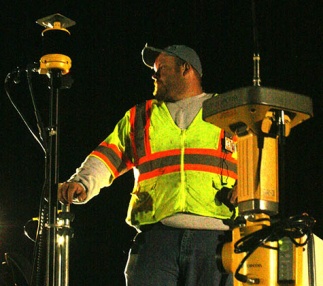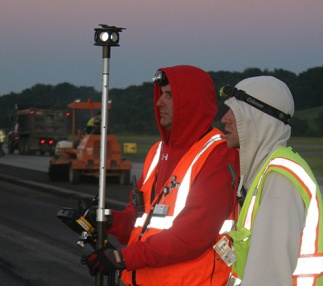Faced with one of the more daunting projects in recent memory — the need to mill and resurface 8,000 feet of airport runway between closing on a Friday night and the first flight Monday morning — paving contractor Summers-Taylor got creative. The firm mobilized an impressive fleet of milling and paving equipment, then, to meet tight FAA-mandated specs, “powered” a good part of it using Topcon Millimeter GPS. The end result was a project that succeeded on all counts and kept a vital link into and out of the region active.

Tight window
Tri-Cities Regional (TRI) serves the northeastern part of the state and has gone more than 20 years since its last resurfacing. While the idea of working in five-hour windows between the last flight each night and reopening in the morning was looked at, it was abandoned in favor of closing the facility down for two full weekends. One would be used to complete milling and lay down a 2 ½ inch binder course, the second to pave a 1 ½ inch surface for the entire runway, complete any shoulder work and place sod.
To get the production needed in that compressed time frame, Summers-Taylor, working through milling subcontractor Delta Contracting, Inc. (Haw River, North Carolina) had seven Wirtgen 2100 milling machines onsite — six active, one on standby.
“Three of those milling machines were running Topcon Millimeter GPS, the other three were simply joint matching,” according to Grant Summers, president of Summers-Taylor. “We had anywhere from 80 to 85 dump trucks working in rotating shifts to handle the material removal.”
Every paver Summers-Taylor used at the TRI project was equipped with a Topcon Paving System Five machine control package, which included dual sonic trackers, slope control and a sonic averaging system. Each paver employed five-foot wide fixed extensions to allow paving a total of 15 feet per pass.
“We had anywhere from 80 to 85 dump trucks working in rotating shifts to handle the material removal.”
Grant Summers, President of Summers-Taylor
Collaborative effort
While the use of Millimeter GPS was not always a foregone conclusion, a conversation with colleagues at Charleston, South Carolina-based Banks Construction steered Summers-Taylor toward that technology. The two firms met to discuss issues like paving ability, operations, what would and wouldn’t work, etc. “We agreed that Topcon Millimeter GPS would be the way to go, so we sat down Delta to make sure they were comfortable milling with GPS,” said Summers. “Once we had everyone’s buy-in, we felt like we had a team assembled that could tackle such an unforgiving project.”

From the outset, Millimeter GPS proved invaluable correcting existing grade and slope deficiencies that existed throughout the runway. “While there were areas in which we were milling as deep as five inches, there were others in which we hardly milled anything,” said Summers. “The important thing was to have it prepared so that the pavers could simply run dual averaging and maintain the tight ±1/4-inch tolerances. Getting to that point using hubs or stringline would have been nearly impossible and prohibitively time-consuming. We were banking on Millimeter GPS and it came through for us.”
Reaching the rate
As part of the Millimeter GPS package, four Topcon PZL-1 transmitters were placed — two on either side of the runway, roughly 500-700 feet from each other. Each transmitter sends out a signal that fans out to a height of 33’ and up to 2000' in diameter — literally creating a wall of light. Using the technology, Summers-Taylor was able to both achieve vertical accuracies within a few millimeters and meet production goals. Once the milling operation moved out of one transmitter’s range, the milling machines switched seamlessly to the next. The out-of-range receiver was then leap-frogged to the front affording uninterrupted coverage.
“We were initially hoping to get production rates of in the 35 to 40 feet (12-14 meters) per minute range,” said Cox. “Due to some unrelated issues at the outset, the first pass took us six hours. However, we brought that down to four hours on the return pass and it continued to improve from there forward. We eventually settled in right on target: at 3 ½ hours per pass or about 40 feet of production per minute.”
By project’s end, more than 23,000 tons of asphalt had been milled off and roughly 56,000 tons of new asphalt was laid down — enough to pave 22 miles of four-lane highway.
“There’s no denying that the technology we called upon out there — particularly the Millimeter GPS in the milling operation — played a huge role in the success of the project. We were able to meet some very tough deadlines, maintain the tight tolerances and have the airport open for business on time. Everyone involved in the project, from our own team to the many subcontractors on site, really stepped up and performed at an exceptionally high level. We were very pleased with the way things turned out.”
















